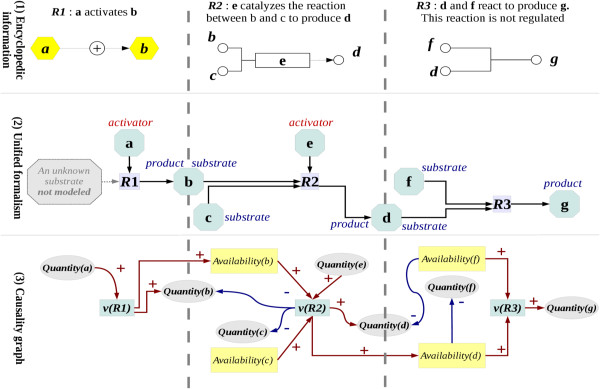Figure 1.
A new unified formalism merging reactions and effects and its interpretation in a causality graph. This graphical scheme illustrates the successive steps in the conversion of irreversible reactions available in encyclopedic database in a causality graph. (1) Common knowledge: encyclopedic information about mammalian cell metabolism and its regulation generally refer to two different concepts: i) the effects (r1) that describe the consequence of the variation induced by a regulator (e.g., a, a transcription factor; e, an enzyme) on reactions (e.g., rate of transcription, speed of reaction), and ii) the reactions (r2) that catabolize substrates (e.g., b or c) to produce newly formed molecules (products; d). Regulators may have a positive (activator) or a negative (inhibitor) effect, or could affect the reaction with a sign which is not yet properly referenced (modulator). (2) Unified formalism: a new common formalism of “regulated reactions” was proposed. The effects were modeled as reactions that were regulated by a regulator and that produced a regulated product using a not limiting and not modeled unknown substrate. This formalism clearly distinguished between the fluxes of substrates and products, on the one hand, and reaction speed, on the other, this latter trait being dependent on the amounts of regulators. (3) Causality graph: Under the quasi-stationary hypothesis, the reaction speed was described as an increasing function of the availability of each substrate and of the amounts of each activator, a decreasing function of the amount of each inhibitor, or a monotonous function of the amount of each modulator, respectively. The causality graph described the variations in the amounts of molecules, the speeds of reactions, and the fluxes (as nodes); it predicted their consequences as edges (positive: +, negative: - or unknown: ?). Both regulated reactions and reactions that were not explicitly regulated could be considered in this formalism.

